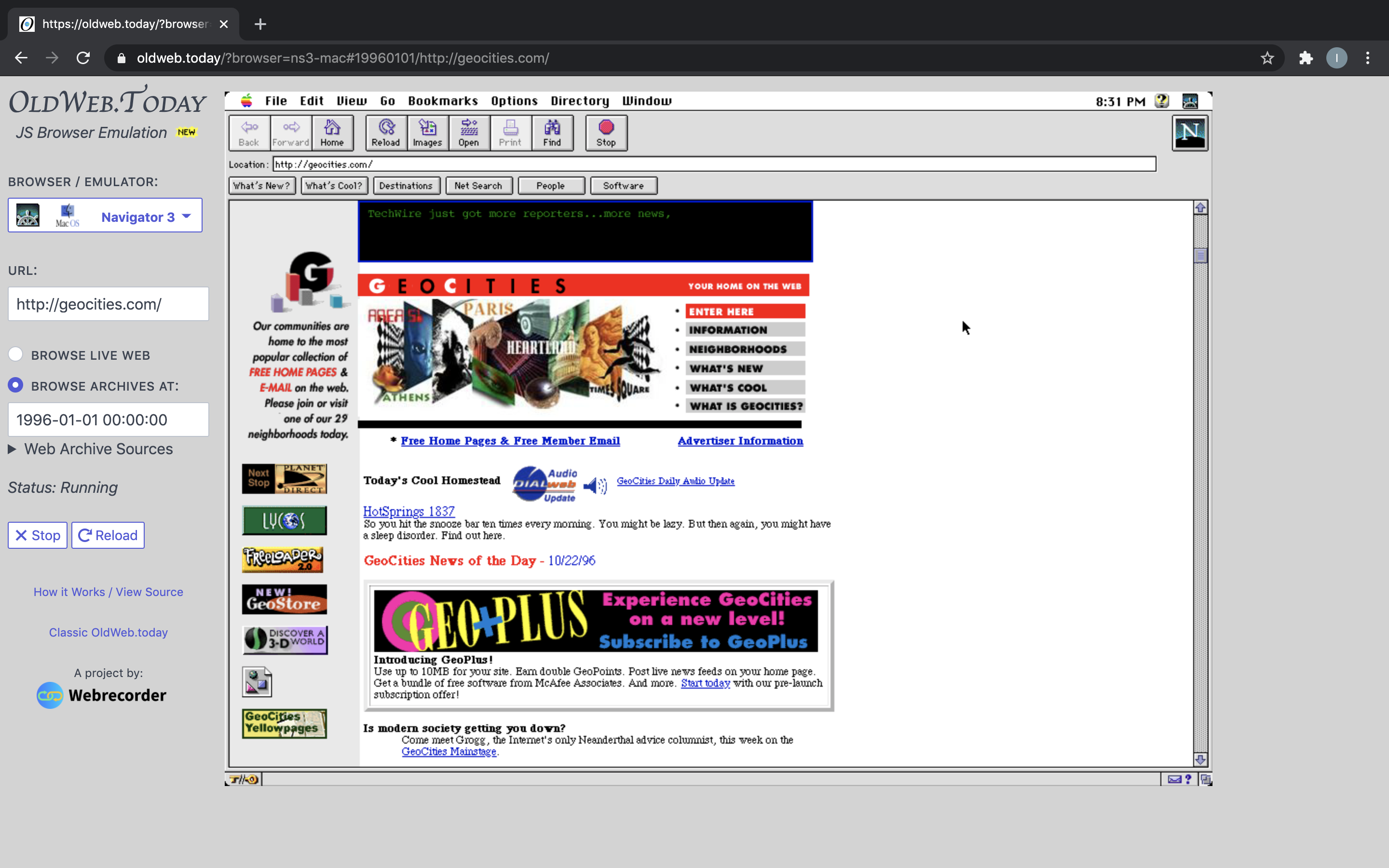Announcing the New OldWeb.today
Just over five years ago, at the beginning of December 2015, I released the initial version of OldWeb.today, which demonstrated running emulated browsers connected to web archives.
Just over five years ago, at the beginning of December 2015, I released the initial version of OldWeb.today, which demonstrated running emulated browsers connected to web archives. This system used Docker to run emulated versions of browsers in the cloud, and required significant resources to maintain and could only support a fixed number of users at a time. (The old version of OWT is still available as classic.oldweb.today)
I imagined that this would be a temporary solution, and that eventually emulators will run fully in the browser.
Today, thanks to the work of numerous emulator developers and advances in Javascript and related technologies, I am excited to announce a fully Javascript/WebAssembly, browser-based OldWeb.today. This version supports three different emulators, all running entirely in the browser, limited only by your own CPU! Sound should fully work in this version as well.

The Basilisk II emulator is used for running MacOS up to System 7 and is used to run several early browsers, including early versions of MacLynx, Mosaic, Netscape, IE.
The v86 emulator is used to run Windows 98, and is presented with a version of Netscape and IE 5 and IE 6. (That’s right, IE6 is back!)
These emulators were modified to support a custom in-browser network stack (ethernet, tcp/ip) implementation, developed by the bwFla Emulation as a Service team. The stack allows connections from thee emulators to be handled in your current browser, and directed to either a web archive or to the live web.
The final emulator included is Ruffle, an open-source Flash emulator that is used to replay any web page with Flash enabled.
Differences from classic oldweb.today
Unlike the original, the entire system can be deployed as a static site, and easily integrated with existing web archives, if desired.
More details on the architecture and deployment can be found on GitHub.
Compared to classic oldweb.today, this version includes only browsers that can be run in a JS-based emulator.
This version includes IE 5, IE 6 and additional 68K Mac based browsers. All emulated browsers also support sound output.
Currently, this version focus on Mac, Windows browsers and Flash, but Linux based browsers could certainly be added as well.
Support for multiple web archive sources, similar to the original, is planned for a future update.
(Not) Gone in a Flash?
Much has been said about Flash ‘no longer being available’, but in reality, the end of Flash is not really the end. Thanks to easily accessible emulation, Flash can continue to be made accessible in a variety of emulation environments. OldWeb.today features old version of Macromedia Shockwave in MacOS browsers, Flash player 9 in IE5 and IE6, and the new Ruffle emulator running in your own browser. Does this cover all Flash works? Not yet, but advancements in emulation technology will continue to ensure that Flash remains accessible.
Here are just a couple of examples of Flash-based works, loaded with Ruffle:
For example, here are two ways to view another MOMA exhibition piece that requires Flash:
The Ruffle version is the fastest, but may not work as accurately. Until then, you can try the IE 6 version, which is more sluggish — an entire Windows 98 + IE6 is loaded in your browser after all! However, the result should generally be more accurate.
For example, an animation (from the excellent list of Physics Flash Animations), can be loaded in multiple browsers using OldWeb.today:
As the underlying emulators, Basilisk II, v86 and Ruffle will continue to be improved, I expect the number of viable options for viewing Flash to only continue to grow!
Remember Java Applets?
Before Flash, there was another technology that reached the end of life: Java Applets. Yet, many applets do remain in web archives and online, especially within academic department websites.
Today these applets can continue to be accessed directly in your browser using OldWeb.today.
Old Web and Web Archives
With the relaunch of OldWeb.today, Webrecorder is committed to making access to archived web as accessible as possible.
These examples above include both live web site and sites loaded from public archives. Currently, OldWeb.today can load from the Internet Archive Wayback Machine, and future improvements will support loading from multiple archives, similar to the previous version of OldWeb.today.
It is easy to deploy OldWeb.today as part of your web archive, pointing to a different wayback machine endpoint. See the README for more details or get in touch with any questions.
The system can support additional browsers, and the goal is to add more browsers in the future when time permits.
The biggest risk to Flash, like any web content, is that the data is no longer available.
Web archiving with Webrecorder tools, such as Webrecorder Desktop can help you archive any Flash content to ensure that it does not disappear.
Stay tuned for additional tools from Webrecorder to make archiving Flash even simpler!
An open source thank you!
It is important to acknowledge that this project was only possible by building on many open source tools and projects. In particular, it was possible thanks to the tireless work of emulator developers, Fabian who created v86, James Friend who ported to Javascript and Christian Bauer who developed Basilisk II, Rafael Gieschke of Emulation as a Service who built the Javascript network stack, and of course the work of all developers working on the Ruffle project. Continued access to digital web heritage is only possible through continued commitment and support of the open source software ecosystem.
Have feedback?
Have any thoughts/feedback/suggestions on OldWeb.today? Feel free to discuss and share on our forum!